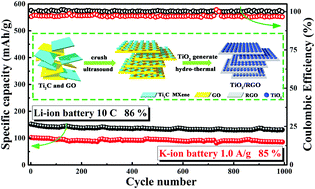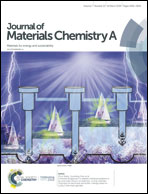MXene-derived TiO2/reduced graphene oxide composite with an enhanced capacitive capacity for Li-ion and K-ion batteries†
Abstract
Li-ion and K-ion batteries present their unique advantages of high energy density and low cost, respectively. It is a challenge to explore a universal anode with efficient electrochemical performance. Herein, a two-dimensional TiO2/reduced graphene oxide (RGO) composite was prepared by a facile hydrothermal method. TiO2 nanoparticles are transformed from Ti2C MXene and connect the RGO nanosheets to form a sheet-like structure. Serving as the anode material, the TiO2/RGO presents high capacity, remarkable rate ability and long cycling performance for both Li- and K-ion batteries. The superior electrochemical performance is attributed to the short ion diffusion path due to the small particle size (15–25 nm) and the highway for electron transport provided by RGO. In addition, RGO motivates the capacitive contribution, resulting in enhanced capacity and better rate performance. Meanwhile, the electrochemical kinetics of Li/K-ion storage was investigated by quantitative kinetics analysis. This work demonstrates a possibility to introduce the capacitive capacity to realize rapid ion storage and improve the cycling stability, providing a new strategy to design efficient electrodes for metal-ion batteries.

- This article is part of the themed collection: 2019 Journal of Materials Chemistry A Most Popular Articles


 Please wait while we load your content...
Please wait while we load your content...